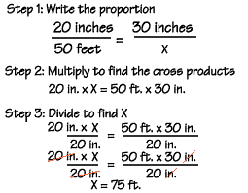Vocabulary
Equivalent Ratios- Two or more ratios that simplify to same comparative ratio.
Proportion- An equation beginning with two rations that are equivalent are called proportion.
A proportion is simply a statement that two ratios are equal. It can be written in two ways: as two equal fractions a/b = c/d; or using a colon, a:b = c:d. The following proportion is read as "twenty is to twenty-five as four is to five."
Here, 20 and 5 are the extremes, and 25 and 4 are the means. Since the cross products are both equal to one hundred, we know that these ratios are equal and that this is a true proportion.

First, write the proportion, using a letter to stand for the missing term. We find the cross products by multiplying 20 times x, and 50 times 30. Then divide to find x. Study this step closely, because this is a technique we will use often in algebra. We are trying to get our unknown number, x, on the left side of the equation, all by itself. Since x is multiplied by 20, we can use the "inverse" of multiplying, which is dividing, to get rid of the 20. We can divide both sides of the equation by the same number, without changing the meaning of the equation. When we divide both sides by 20, we find that the building will appear to be 75 feet tall.

http://www.math.com/school/subject1/lessons/S1U2L2DP.html
VIDEO HELP
https://www.youtube.com/watch?v=etJKZCudqiM
https://www.youtube.com/watch?v=_Lcj_kWacSE
https://www.youtube.com/watch?v=YnIDeuNt29k
No comments:
Post a Comment